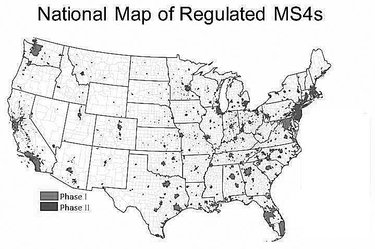EPA fines Voorheesville for not properly managing stormwater
— Map from the United States Environmental Protection Agency
All across the country, municipal separate storm sewer systems, known as MS4s, are required to protect bodies of water from pollution. The federal Environmental Protection Agency implemented the MS4s in two phases: The 1990 Phase I required medium and large cities and certain counties to get federal permits for stormwater discharges; there are about 855 Phase I MS4s covered by 250 permits. The 1999 Phase II required small MS4s — like the one in Voorheesville — in urbanized areas to get permits; most of the 6,695 Phase II MS4s are covered by state permits. Regulated MS4 areas cover 4 percent of the land in the United State and serve more than 80 percent of the population, according to the EPA.
VOORHEESVILLE — Last month, the village board authorized payment of $6,200 in fines to the federal Environmental Protection Agency for violations of the Clean Water Act.
Richard Reilly, the village attorney, told The Enterprise this week, “I had a fair amount of back and forth with them” to get the penalty reduced from the original $11,000. The fine will be paid in eight installments.
“It had to do with administrative aspects of stormwater management,” said Reilly of the fine. “The EPA did an audit and identified issues.”
Reilly gave two examples of violations: not all the village storm drains were stencilled to warn against dumping waste in them, and an annual required report by the building inspector was prepared but not presented publicly at a meeting.
“We worked with Barton and Loguidice,” said Reilly, referencing an engineering firm hired by the village. “Six to nine months after we rectified everything, we received notice of the fine….I thought they were asking a lot for what had happened.”
He concluded of the penalty, “There were administrative shortcomings we moved to rectify, hiring an outside engineer...It’s disappointing to say the least.”
Voorheesville is a village with fewer than 3,000 residents and a roughly $2 million annual budget.
The Enterprise obtained a copy of the EPA audit report (posted in full online at AltamontEnterprise.com), which was conducted in June 2015 and lists 24 violations, detailing them in nine pages.
The report explains that the village owns and operates a small municipal separate storm sewer system, known as an MS4, that discharges stormwater, which is a pollutant, into the Vly Creek, a Hudson River tributary. The village received authorization from the state’s Department of Environmental Conservation in May 2003 to operate its system.
Tayler Covington, an EPA spokeswoman for Region 2, which covers New York and New Jersey, said in emailed responses to Enterprise questions that Voorheesville missed the deadlines required by its DEC permit, resulting in an EPA Administrative Order, to which Voorheesville complied.
Asked how the amount of the fine is determined, she said, “There is a penalty policy that takes the type and duration of the violation, along with other factors, into account.” She also said, “We do take compliance into account.” The money goes to the United States Treasury, she said.
“We believe that penalties can serve as a deterrence,” said Covington. Generally, she said, the penalty is negotiated and a settlement is reached, as it was with Voorheesville. If a settlement cannot be reached, the matter goes to a hearing.
In response to the two violations that Reilly mentioned, Covington said, “The purpose of the stenciling is to make people aware that those storm drains lead to a river, lake or bay with no prior treatment and that if people dump pollutants into the municipal separate storm sewer systems (MS4) catch basins or storm drains, it could harm the receiving water body.”
On the need for presenting the annual report at a meeting, Covington said, “Ensuring that the annual report is available to the public raises awareness of the threats, what the village is doing, how they can prevent pollution. In addition, the annual report must be presented to the public for questions and comments and the final report must include the MS4’s intended responses to the public.”
Violations
Other violations at the time of the audit included:
— The village was required to develop and fully implement a stormwater management program, known as a SWMP, by Jan. 8, 2008 and, while Voorheesville did provide the EPA with a SWMP dated May 22, 2013, it did not included 19 needed elements, for requirements like involving and educating the public; or having an inventory of active construction sites and the plans to manage stormwater there; or techniques to reduce the use of fertilizers, pesticides, and herbicides;
— Voorheesville was “not fully implementing its SWMP,” for example, not training workers annually on spill containment;
— The village was “unable to provide a signed certification statement, contract or agreement that provided adequate assurance that third parties will comply with permit requirements”;
— Voorheesville had not identified pollutants of concern, known as POCs; waterbodies of concern; geographic areas of concern; and target audiences, nor had it educated the public about these;
— Voorheesville had, in November 2011, identified a potential illicit connection discharging soapy water but could not provide documentation or a description of follow-up actions;
— Voorheesville had not kept up with requirements for mapping outfalls. An outfall is the discharge point of a waste stream into a body of water;
— Village representatives were unable to document certification that a required ordinance had been adopted prohibiting illicit discharges. Further, the village had not developed procedures for identifying, locating, and eliminating illicit discharges;
— The village did not have written procedures for receipt and follow-up on complaints by the public regarding construction-site stormwater runoff;
— Voorheesville did not have written procedures for construction-site inspections beyond an undated checkmark nor did it have written records that construction site operators received erosion and sediment control training;
— Voorheesville had no documentation of an ordinance requiring post-construction runoff controls from new development and redevelopment projects nor did it have a post-construction program by trained staff to perform inspections; and
—Voorheesville had not completed and document the required self-assessment of its stormwater management program, to determine the sources of pollutants, which is required at least once every three years.



